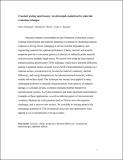Transient grating spectroscopy: an ultrarapid, nondestructive materials evaluation technique
Author(s)
Hofmann, Felix; Short, Michael P.; Dennett, Cody
DownloadAccepted version (5.547Mb)
Open Access Policy
Open Access Policy
Creative Commons Attribution-Noncommercial-Share Alike
Terms of use
Metadata
Show full item recordAbstract
Structure-property relationships are the foundation of materials science and are essential for predicting material response to driving forces, managing in-service material degradation, and engineering materials for optimal performance. Elastic, thermal, and acoustic properties provide a convenient gateway to directly or indirectly probe materials structure across multiple length scales. This article will review how using the laser-induced transient grating spectroscopy (TGS) technique, which uses a transient diffraction grating to generate surface acoustic waves and temperature gratings on a material surface, nondestructively reveals the material's elasticity, thermal diffusivity, and energy dissipation on the sub-microsecond time scale, within a tunable subsurface depth. This technique has already been applied to many challenging problems in materials characterization, from analysis of radiation damage, to colloidal crystals, to phonon-mediated thermal transport in nanostructured systems, to crystal orientation and lattice parameter determination. Examples of these applications, as well as inferring aspects of microstructural evolution, illustrate the wide potential reach of TGS to solve old materials challenges and to uncover new science. We conclude by looking ahead at the tremendous potential of TGS for materials discovery and optimization when applied in situ to dynamically evolving systems. ©2019
Date issued
2019-05Department
Massachusetts Institute of Technology. Department of Nuclear Science and EngineeringJournal
MRS Bulletin
Publisher
Cambridge University Press (CUP)
Citation
Hofmann, Felix, Michael P. Short, and Cody Dennett, "Transient grating spectroscopy: an ultrarapid, nondestructive materials evaluation technique." MRS Bulletin 2019 (May 2019): p. 392-402 doi 10.1557/MRS.2019.104 ©2019 Author(s)
Version: Author's final manuscript
ISSN
1938-1425
0883-7694